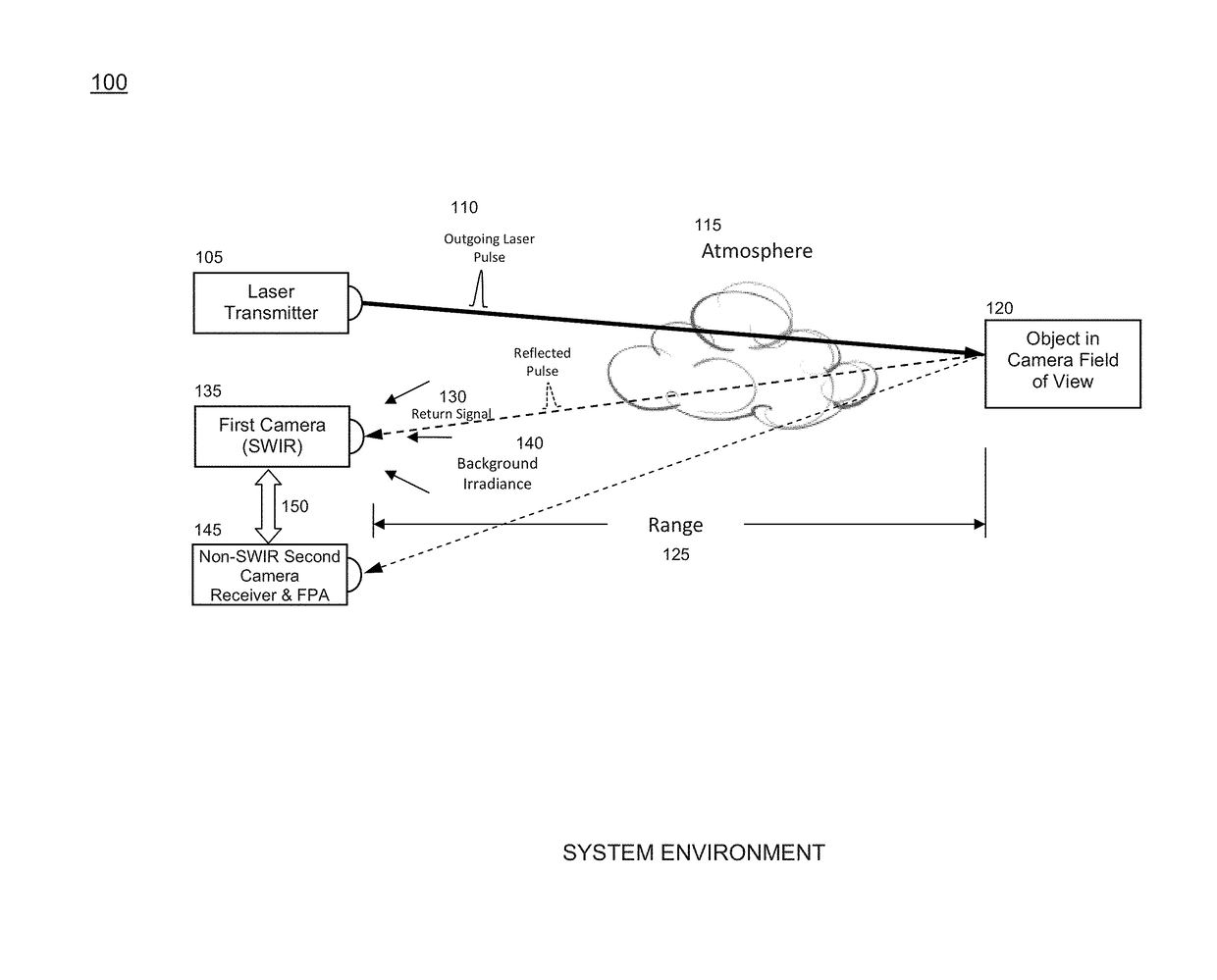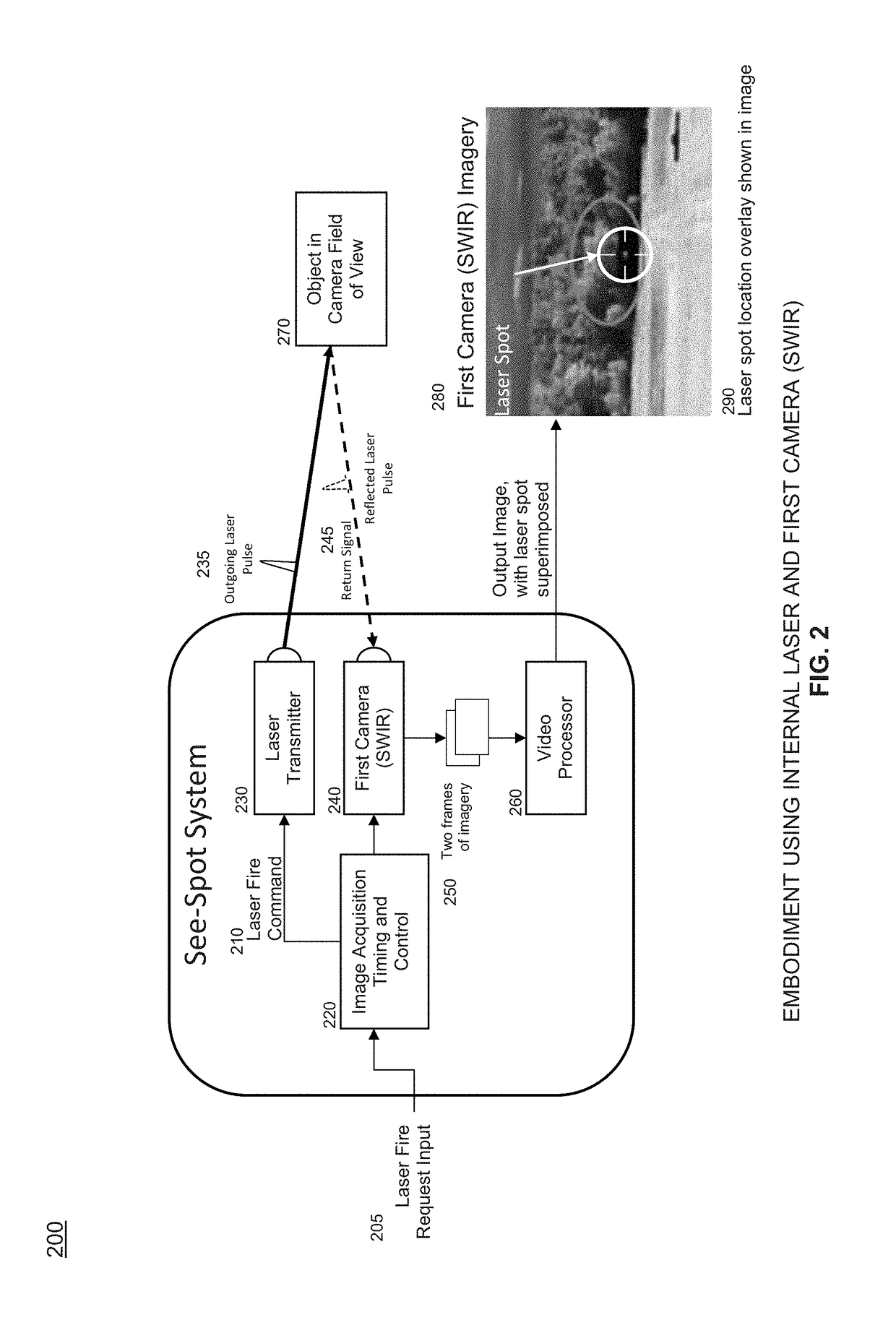Laser detection and image fusion system and method
a laser detection and image fusion technology, applied in the field of targeting systems, can solve the problems of complex task, high undesirable, and the condition is not readily detectable by the operator, and achieve the effect of eliminating background clutter and reducing the duration of exposure windows
- Summary
- Abstract
- Description
- Claims
- Application Information
AI Technical Summary
Benefits of technology
Problems solved by technology
Method used
Image
Examples
embodiment 200
[0065]FIG. 2 depicts an embodiment 200 which incorporates internal pulsed laser transmitter 230 as the source to illuminate object 270 with laser pulse 235. Operation is as follows. The operator provides external input 205 to request that laser 230 output a pulse 235. This request is applied to Image Acquisition Timing and Control element 220 which sends Laser Fire command 210 to laser transmitter 230 to cause a laser pulse 235 to be output at the appropriate time. Image Acquisition Timing and Control element 220 provides image acquisition frame timing and exposure timing signals to First Camera 240 to control the image acquisition process. In alternative embodiments, Image Acquisition Timing and Control element 220 may instead receive some or all of these timing signals from first camera 240 as an indication of the image acquisition process occurring within that camera. The Exposure Timing and Control element determines when to initiate a laser pulse firing based on the timing of f...
embodiment 400
[0068]FIG. 4 depicts an embodiment 400 of the timing internal to the Image Acquisition Timing and Control elements (220, 320) depicted in embodiments 200 and 300 which controls the firing of a laser pulse (235, 335) by synchronizing the generation of the Laser Fire command (210, 310) such that the reflected laser pulse (245, 345) arrives at the first camera (240, 340) while the camera exposure window is open thereby acquiring energy from the scene.
[0069]The Frame Sync signal 410 is a periodic command issued by the Image Acquisition Timing and Control element to the first camera to acquire the next frame of imagery. Typically, each rising edge of the waveform initiates the acquisition of a frame of imagery. The frame time 412 is the interval between successive Frame Sync pulses.
[0070]The first camera (240, 340) begins the process of acquiring an image when it receives a Frame Sync signal 410. The camera opens the focal plane exposure window 460 which allows the pixels comprising the ...
embodiment 800
[0082]FIG. 8 depicts an embodiment 800 which is based upon use of external laser designator 890 or other external pulsed laser source as the means to illuminate object 870. Laser designator 890 is external to the invention and is not under the control of the invention.
[0083]Operation is as follows. Laser designator 890 issues outgoing laser pulses 895 in a known or otherwise predictable pattern. These pulses are reflected by object 870 being illuminated by the laser. The reflected pulses represent the return signal and are acquired by both laser receiver 830 and first camera (SWIR) 840. The output signal from laser receiver 830 is input to Pulse Repetition Frequency (PRF) Predictor element 810. The PRF Predictor analyzes the pattern of incoming laser pulses 835 allowing it to predict the arrival time of the next laser pulse. This predicted arrival time information 815 is provided to Image Acquisition Timing and Control element 820 which initiates and controls the capture of two fram...
PUM
 Login to View More
Login to View More Abstract
Description
Claims
Application Information
 Login to View More
Login to View More - R&D
- Intellectual Property
- Life Sciences
- Materials
- Tech Scout
- Unparalleled Data Quality
- Higher Quality Content
- 60% Fewer Hallucinations
Browse by: Latest US Patents, China's latest patents, Technical Efficacy Thesaurus, Application Domain, Technology Topic, Popular Technical Reports.
© 2025 PatSnap. All rights reserved.Legal|Privacy policy|Modern Slavery Act Transparency Statement|Sitemap|About US| Contact US: help@patsnap.com



